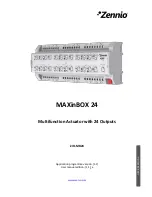
10
EATON CORPORATION Cutler-Hammer
Chiller Starter (AMPGARD) Technical Data TD02003003E Effective: October 2006
Reduced Voltage Starters
Eaton offers traditional electromechanical reduced voltage starters in
addition to the AMPGARD
IT.
solid-state starter. Unless otherwise
specified, reactors and autotransformers are NEMA medium duty
rated. They are designed for three 30-second starters per hour.
Heavy-duty reactors and transformers can be supplied when speci-
fied. Locked rotor current must be specified when ordering reduced
voltage starters to ensure that the reactors or autotransformers are
properly sized.
Reduced Voltage Reactor Starter
TABLE 1. TYPE 502 REACTOR STARTING CHARACTERISTICS
Factory set on 65% tap.
Reactor Starter
Advantages
●
Reduces starting currents.
●
Least costly reduced voltage starting method.
Disadvantages
●
Large footprint: 1-1/2 structures at 400 amperes.
●
“Bump” on transition to full voltage.
●
Not as efficient as autotransformer.
●
Due to reduced torque during starting, motor must typically be
unloaded during the start sequence.
Sequence of Operation
●
Main contactor (M) closes.
●
Current flows through reactor reducing voltage to motor
(based on tap setting).
●
When motor current reaches ~125%, the run contactor
(R) closes providing full voltage to the motor.
Reduced Voltage Autotransformer Starter
TABLE 2. TYPE 602 AUTOTRANSFORMER STARTING
CHARACTERISTICS
Factory set on 65% tap.
Autotransformer Starter
Advantages
●
Produces the most torque per incoming line ampere of any
reduced voltage starting method.
●
Less costly than RVSS.
Disadvantages
●
Large footprint: 1-1/2 structures at 400 amperes.
●
More costly than reactor.
●
“Bump” on transition to full voltage.
●
Due to reduced torque during starting, motor must
typically be unloaded during the start sequence.
Sequence of Operation
●
Shorting contactor (S) closes.
●
Main contactor (M) closes.
●
Current flows through autotransformer reducing voltage to motor
(based on tap setting).
●
When motor current reaches ~125%, the shorting contactor (S)
opens and the run contactor (R) closes providing full voltage to the
motor.
Note:
Since the motor is never disconnected from the supply
voltage, the starting is closed transition.
STARTER
TYPE
% MOTOR
VOLTAGE
% MOTOR
CURRENT
% LINE
CURRENT
% TORQUE
80% Tap
65% Tap
50% Tap
80
65
50
80
65
50
80
65
50
64
42
25
STARTER
TYPE
% MOTOR
VOLTAGE
% MOTOR
CURRENT
% LINE
CURRENT
% TORQUE
80% Tap
65% Tap
50% Tap
80
65
50
80
65
50
67
45
28
64
42
25











































